FOLLOW US ON SOCIAL MEDIA:
LOCATION: Thürmchenswall 66 | D-50668 Köln
EMAIL: leila.cheraghi @co3art.com
TEL: +49 170 28 91 985
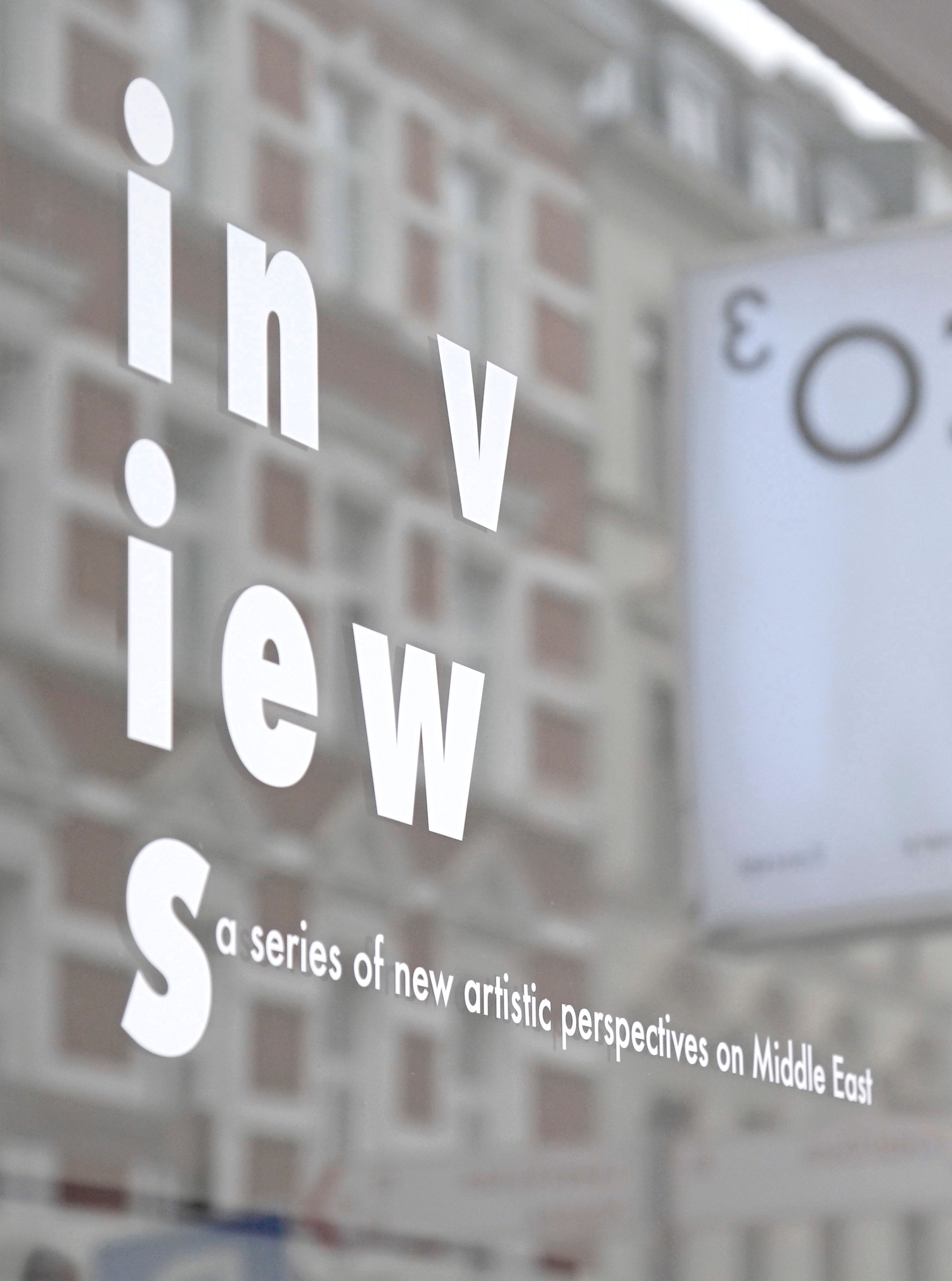
International short films on display as window screenings in Cologne
In November 2020 started the short film series “in views”, hosted by the public charity “Contemporary Middle East e. V.” in Cologne’s hip district of Ehrenfeld. The series consists of a row of window screenings, with a shop-window becoming the stage for presenting art to the audience on its daily paths.
The title of the series does stand for both, the views of the audience through the glass, but also the views of the various artists involved in this project on their personal artistic perspectives and vantage points on the various relations and connections between Western and Middle East culture. By taking individual topics in their view, the artists offer us, the audience, new chances of widening our views. Whether all agree on every provocative aspect discussed in the films or whether this may open up a dialog on different perspectives and views, remains exciting.
After an international Open Call the audience in Cologne will be presented 6 films from different filmmakers and video-artists. Most of the works are on display in Germany for the first time.
The window:
Six short films will be presented in a shop-window in Cologne. The window serves as both, the projection of the film and the amplification of its soundtrack. Without any visible speakers, the street is filled with sound, giving the audience a bodily and intriguing experience that goes beyond the visible attraction.
The concept of such a window screening meets perfectly with the current pandemic-related demand for distancing, as the viewers stay on the street, taking part and ‘entering’ emotionally and intellectually, but not physically.
About Us…
Contemporary Middle East. e.V. (conmidea.org) is a Cologne-based association, founded in 2019 with the purpose of artists support, cultural education and exchange specifically between Western and Middle East cultures. Our goal is to initiate and curate unconventional exhibition-formats, which enable a broad, generation-spanning, socially diverse and multicultural audience to participate in a dialogue about current perspectives on how to come together and understand each other in society, culture or religion – with art being the mediator and catalyst for that dialogue.
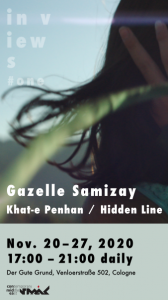
“Holding the hand of a girl, the viewer gets caught in a labyrinth of different forces, as if guided by Ariadne’s thread. Tradition, family, culture, society, nature, seduction, belonging, responsibility … all pull their strings and leave us with it in an enigmatic state of cryptic symbols and signs. The ribbon transforms into a shackle, into calligraphic symbols and becomes invisible while dancing in a row and then shows up shattered and torn apart so as to lead to new paths.
Astrid Menze, supporter of conmidea.org, on the film Khat-e Penhan / Hidden Line by Gazelle Samizay
The works of Afghan-American video artists Gazelle Samizay often reflect the complexities and contradictions of culture, nationality and gender through the lens of her bicultural identity. Various of her projects in photography, video and mixed media have been exhibited to a wider audience across the US and internationally. She was born in Kabul, grew up in Washington and currently resides in San Francisco.
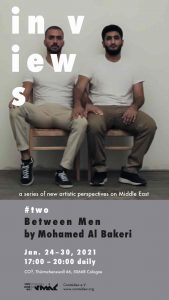
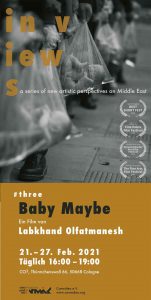
“Baby Maybe” is an experimental short that explores the personal and complex stories of women and their relationship to parenting across age and time. The filmmaker Labhkand Olfatmanesh captures the raw human emotion generated by the experiences of people interacting with ‘real-life’ dolls. With this, Olfatmanesh is finding a way to point the viewer towards love and self-realization.
“Through my work I tell intensely personal and intermingled stories about my subjects myself and my relationship to identity, both in Iran and in the United States. This is a healing methodology expanding from the nature of constriction and expectation in order to mold it towards confrontational vulnerability where I can move beyond identity into larger themes within my practice.”
Artist Statement by Labkhand Olfatmanesh
Labkhand Olfatmanesh is a multidisciplinary artist examining topics of feminism, race and isolation. Her works explore how these forces take dual shape as an immigrant to the United States and in her home country of Iran. Her recent photo and video work has been exhibited in group and solo exhibitions in various locations in the U.K., France, USA and Brazil. Being part of the InViews-series is Olfatmanesh’s first appearance to a German audience.
An excerpt of the film shown in Cologne can be viewed here
See the artist talking about “Baby Maybe” in this video interview
Discover more on Labkhand Olfatmanesh on her website
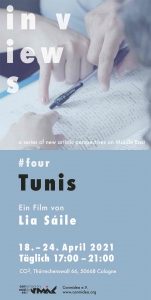
A sea between languages – four German-Tunisians search for words. Translating a poem turns into a long and heated discussion about language, culture, heritage, migration, refugees and — inescapably — politics. A documentary experimental film by Lia Sáile (2018), based on the poem “Tunis” by Adrian Kasnitz (2013).
“Tunis”, with its numerous fade-outs, gives an idea of how long and how intensively the four of them will be engaged in their task. In the end there will be three texts, a poem, a translation and the reverse translation of the first one, which has taken the liberty to rewrite the poem. And the film.
Andreas Altenhoff in: «poetry/film»: Gedichte – Filme – Resonanzen, Köln 2020
I her field of work Lia Sáile explores limits, their transgression and intervening spaces, by interrelating fragments and concepts of reality. She develops artistic forms for experiencing political, cultural and social areas of tension.
Sáile is utilising multiple forms of media and artistic techniques, from film to photo, as well as installations and interventions of sound, light and textile.
Discover more on Lia Sáile on her website
CONVERSATION WITH THE ARTIST, April 2021
On the occasion of our screening in Cologne, Lia Sàile shared the following detailed and very personal views about her work and her self-conception as an artist often working across borders and in intervening spaces.
We are very pleased to show [TUNIS], a work in the in-views series that, with you as a German artist, takes a look at the in-between in intercultural processes and questions. What attracts you to this theme and where does your interest in the Mena region come from?
This question takes me back to the moment when I hesitated, and from then on struggled with myself for a long time, to send you my documentary experimental film [TUNIS]. Am I allowed to place myself under a heading like “contemporary Middle Eastern art” without having genetic, diasporic, cultural roots in the region, for example? Am I pushing myself on a platform where artists can show who presumably have a harder time systemically and structurally presenting in the Western “white” (art) world, who could celebrate their visibility here? At that time, you answered me very openly that you were interested precisely in this interface.
It’s important for me to see if my artistic engagement has an added value, if it opens up something that questions, doubts, seeks, that changes. I want to build on something that is connected to my experience or my cultural “heritage”, my life world. I am concerned to distance myself from problematic ethnographic “studies” and exoticism and yet, especially then, to remain in artistic discourse instead of saying “let them reflect on their own themes and contexts”. Who are “they”? And are they only “their themes”? We live in a globalised, hyper-connected world. What happens in the “Middle East” has many roots as well as effects in the “West” and vice versa. Many politically difficult situations have either arisen in direct connection with the West or have an impact on it.
Germany, the country where I was born, sees itself culturally as a Christian country. I am always fascinated and irritated by the obvious and simple point of tension, that Christianity comes from the Middle East. And that this religion – at least in the Catholic variant – now has its seat, exaggeratedly speaking, in Europe, in its own independent state. I find that totally crazy. To look at the Crusades in which Germany was involved, or to look at the colonial history of Germany and Europe, and then to fast-forward all those centuries to today’s globalised world in which we are interconnected politically, economically, ecologically, geographically in our mobility and also virtually/digitally – all that takes my breath away and makes me ask: who are we, as individuals, as communities, what can we achieve? How do we touch each other, how do we exclude each other, where does our closeness begin, where does the strangeness begin, where are thresholds, where are we under tension, where are frictions, overlaps? What needs to be protected and preserved, what needs to be deconstructed or liberated? [TUNIS] addresses these areas of tension on many levels, which is why it means a lot to me to show the film with you.
You are often described as a frontier crosser. Does this refer to the interdisciplinary artistic fields and forms of expression, does it refer to questions of content or is it to be understood in a literal geographical sense?
The term keeps coming back to me because of my interdisciplinary work as well as my thematic areas. It positions me as an artistic identity-construct in some “in-between”. That’s where I feel very comfortable in my work and the way I live it. It is perhaps even an anti-label. On the one hand, it certainly comes from my geographical unboundedness. I rarely have a studio for more than two years, I like to do without it for a while and tend to work on the move, depending on the project. For my artistic practice, I stay in motion in many ways; from medium, material, places to processes and themes, which I artistically like to condense temporarily and with a lasting openness and then pass them on again, instead of solidifying something flat, sealing it. My wish would be to look at my own work in a few decades and find both in it, the contemporary and the forward-looking.
How did you get into art? What is your motivation to be an artist?
My art arises out of necessity, perhaps that’s how I can sum it up. I can move most freely in it. Art challenges and does not pretend to be anything, if you dare to accept it that way. It’s intimidating, exhausting, as well as enriching and allows you to grow in all directions. So far, everything fulfils and connects in my art. My path here has been both straightforward and convoluted at the same time. I have not gone through a classical artist’s biography. My locations in the art world for over a decade have been self-built, without the handrails of a classical education. I have simply always worked. Only now am I taking advantage of the privilege of an Academy of Media Arts in Cologne as a postgraduate student. I had previously studied theatre, film and media studies in Vienna, which enriched and strengthened me greatly. My roots come from the performative, theatrical and musical fields, and then I went further and further into the diversity of media and materials via photography and moving images.
A very personal question or a feminist digression: You are both an artist and a mother. A common idea is that creating art only works with absolute exclusiveness What does this mean – in your opinion – for the acceptance and the career as an artist? Does being a mother play a role in your work or is it unrelated?
I think this is a great and important question. There is a systemic, structural component to everything that relates to the viability and feasibility of the concept of “mother and artist” in the 21st century, e.g. in Germany. One is “allowed” to do anything – but is it possible? Will one continue to be taken seriously? Is it possible financially? Will you be mentally sidelined? The stories from fellow female artists – not male ones! – range from cancelled residencies and exhibitions, to sexist comments, to simple facts such as that there are hardly any residencies that are family-friendly, let alone galleries that offer childcare on set-ups or show correlating consideration during production runs. These are realities that women with children face that are very difficult to address. Fathers have little to no problem with this (there are studies on this), as it is assumed that their partner will take care of it.
Female artists are often afraid to talk about it, to “come out”. It is still unconsciously assumed that you can’t be good as an artist when you become a mother, as if something is lost forever when you give birth. It is also often assumed that you don’t continue afterwards. The art business is precarious anyway and women are demonstrably at a great disadvantage. There are various strategies of dealing with this, from self-exploitation in the sense of capitalist urge to produce up to burnout, via strategically prefabricated works during pregnancy in order to ‘release’ them in the first year, up to financial expenditure in childcare. Deliberate, relaxed abandonment is probably already an act of protest.
Marina Abramović, whom I hold in high esteem and who has done a lot for women in the arts, said in the German magazin Tagesspiegel in 2016 that women are not as successful as men because they want to have children, which limits their energy. She uses her own biography to show that it is only through renunciation that one can ultimately become a successful artist. This seems to me like a belief system that actually no longer belongs in a community of solidarity, a modern democracy that tries to create equality, and clearly wants to exclude and limit women. But it certainly also leans on the mystery of the male genius and his creative work.
I would like to give courage; since I feel I work partly more efficiently and more patiently, my ideas arise in new processes, which I also attribute to the meditative moments, the deceleration, the withdrawal, the new way of dealing with things. My focus has sharpened, my interests continue to mature, new insights and experiences are added. I actually feel enriched and more productive above all. But this is also due to my partnership situation. Last but not least, the increased vulnerability and sensitivity, for me, allows a whole new way of thinking and working. In my professional environment, I received – after having become a mother – mainly positive feedback and new offers of work and help.
In this respect, I like to act as a role model and activist, because in a way I am still something of a trailblazer and want to contribute to changing structures by talking about it and calling for change. By the way, there are also various initiatives that address the issue, for example “And She Was Like: Bäm!” in Cologne or “Kind & Kunst” in Munich.
Can you tell us something about the process of making [TUNIS]? Give us a look behind the scenes?
This documentary experimental film, in which four German-Tunisians from the Cologne-based association Voices of Jasmine e.V. translate a poem by a German man, Adrian Kasnitz, apparently about the city of Tunis, into Tunisian-Arabic and in the process raise more and more questions about language, culture, identity and politics, is a border blaster in many respects. I could now go into the many different dimensions of the content of the conversations that have brought interculturality to life so brilliantly between these four minds. But I will let the film do that at this point. Let’s go into the artistic realisation instead; because that starts with the genre and created a lot of obstacles for me at the beginning; poetry films are a genre in which poems are often cinematically illustrated or narratively realised, maybe sometimes descriptively experimental; there are many great works there. But to develop an almost documentary format in this genre, recording a conversation *about* a poem, let alone *translating* it, especially into Arabic dialect, with the process also being the relevant aspect, not the poem itself – all of ths went too far for some. I have had to hold very tightly to the concept and see it through against resistance and questions. Incidentally, an eternal concomitant of my work, as it rarely fits into a format or genre. The film explodes the genre, breaking out of its own boundaries, and in the process fans out various new levels.
Another aspect, for example, is the English subtitle, which is an essential part of the art work rather than just an accompanying medium of mediation. It brings a fourth language into play, which is visually superimposed on the filmic one as a further level. In this language, too, not all of the German-Tunisians’ word-search moments are translated, just as in the acoustic part of the film. This means that some terms are only revealed to Arabic speakers or will only become clear in the further course of the film. This is further intensified by the insertion of Arabic writing of some words, which also remains cryptic, thus elevating the non-understanding to another level and making it visible. Another exciting step, which you can hardly imagine in retrospect, was also the transcription of all the material, as well as the entire translation of all the Arabic and French parts, done with time markers to make the editing possible for me. Ferdaous Kabteni did that very meticulously. So the post-production was also based on translation and return to the medium of text.
Visually, the film is a hybrid of documentary approach colliding with an almost studio-like production design of a sofa scene, which was in fact simply my living room at the time. Visually, the action is captured very sensitively, aesthetically, lyrically, in close-ups. There are no wide shots, the room is not broken up or explained, the artificially created context of the conversation is not elucidated. One enters in the middle of the conversation. Black fades fragment the process, refer to the blurring of the cinematic and the real time, let some sentences hang and reverberate in the in-between, in the void. The search for words, the exchange between the protagonists is on an incredible level.
My fantastic director of photography Katja Rivas Pinzon carried a heavy handheld camera on her shoulder for 6 hours and did such a great job of implementing my desired format of circling closely around the speakers and their texts, gestures, books, glances. Here, too, I was advised several times to also include long shots, to use several cameras, to include more silent positions in order to correspond more to a classic conversation setting, but for me the dynamic of being in the middle, the fragmenting, was the most important aspect of the work. It’s about the process itself. The film production also clearly exceeded the planned day-night limit, as we never thought we would be shooting for so long. In retrospect, I am endlessly grateful to Rivas Pinzon for insisting on a single spotlight, which I refused several times – ’cause we would have been sitting in the dark and I could hardly have done the a-chronologically editing. Actually, the editing process was a nerve-wracking marathon; assembling 6 hours of footage in 15 minutes, letting go of many favourite moments, tightening, reducing, leaving more space, letting it unfold – a wonderful ordeal when you know the material. Film editing is a borderline experience in itself anyway.
You have already realised and exhibited many interesting projects. Many have site-specific references. What is the significance of place in your art?
I think, recognizing places as negotiable in-between-places and non-places, as catalysts, narrative agents that open up associations, is one of the most important aspects for me. And this does not always necessarily manifest itself in the final work. The title [TUNIS] is a nice example, in which everything revolves around a place that you never see, that points beyond itself, as something near and far at the same time.
What else are you currently working on? What can you make us curious about?
For example, a project funded by the city of Munich, which will take place in May, was initiated by the Pulse of Europe association, which approached me. (As a side note, they immediately offered baby care & co in the implementation!) The association asked me to develop an art project in public space for them, dealing with the theme of solidarity in the context of the European Union. As will come as no surprise, I have strongly deconstructed the theme and have now found what I consider to be a dynamically touching, expansive approach; the work will consist of over 70 metres of fabric. Here, too, I have not left the threshold to the Middle East untouched, that much is already revealed…
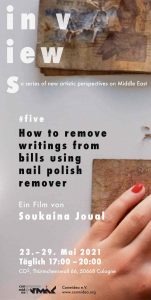
“With my best regards, for the eternal memory, congratulations, I Love you…” are some of the phrases that are found daily on Egyptian banknotes, which many use to record moments of significance to them. These moments can be a birthday or a souvenir for a person, lovers use it as well to write love phrases as a memory. This form of expression evolved with the Egyptian political precarity to become a way to manifest resilience and solidarity.
All that has become a hindrance since March 2019, after the Egyptian Central Bank prohibited the circulation of any banknotes that carry text phrases or seals, and that they will no longer be accepted in banks.
“How to Remove Writings From Bills Using Nail Polish Remover” is the video-capture of a performance by Soukaina Joual in which the artist performs a simple repetitive process of cleaning the bills, each one of them becoming slowly damaged, shredded and loses its function or value.
Soukaina Joual is a Moroccan multi-disciplinary artist who’s live-performanes have been part of various projects in institutions and spaces in Morocco, Germany, France, Japan, Egypt and South Korea.
Discover more on Soukaina Joual on her website
And here’s an interview we did with the artist about the making of “How to Remove Writings From Bills Using Nail Polish Remover”:
Your origin is Morocco, so how did you come to this idea to make a video-performance about the “notices” on Egyptian banknotes?
During my one year residency in Egypt back in 2018-2019, I developed different projects and one of them is “How to Remove Writings From Bills Using Nail Polish Remover”. I worked on this video-performance as a response to the Egyptian Central Bank prohibiting the circulation of any banknotes that carry text phrases, seals or graphic characters and slogans, and that they will no longer be accepted in banks. This decision was also in response to this form of expression evolved with the Egyptian political precarity and became a way to manifest resilience and solidarity.
I was also inspired by many Egyptian articles that came out following the decision. The articles showed different ways to get rid of handwriting on banknotes. I decided to follow these steps to clean the bills, which left each one of them damaged, shredded until it loses its function and value.
Do the people write phrases on Moroccan banknotes also? If yes, have you realized any differences to the Egyptian phrases?
Upon my arrival to Egypt, one of the things that caught my attention was the writings, phrases and seals on the banknotes. People use handwriting on banknotes to record moments of significance to them; a birthday or greetings for a person, love phrases, or a souvenir.
On the contrary, Morocco’s Penal Code prohibits the deliberate use of a note or a coin as a medium for a message, advertising and even writing on it.
In your point of view, what do these following dualities have to do with the writing phrases on the banknotes: public and private space; the individual and the community; visibility and invisibility; belonging and absence?
The writing phrases act as a form of expression, a silent demonstration, a medium of exchange that circulates publicly and privately; and goes beyond the individual.
The act of prohibition and removing the writings from bills, can be seen as a way of erasing a collective memory, the identity that shapes a community.
Catchy red nail polish! What was the thought behind it?
I intended to leave a small token to the viewer, for them to see how the red nail polish I am wearing reacts with the nail polish remover during the one hour performance. It slowly wears off at the edges, as the pile of banknotes increases and the writings are removed. Something about this imagery I also find to be uncanny; the slow and repetitive destruction of the bills and the delicate handling of the bills in a backdrop that seems so neat, almost surgical.
As a multi-disciplinary artist you use different materials and methods for making your artwork. How do you get your inspiration for doing your art?
My practice has always been heavily influenced by my surrounding environment, my experiences and encounters. The choice of medium then becomes intuitive, in the sense that when I fully immerse and engage with a certain context, there is usually a moment of understanding that points me towards the appropriate medium.
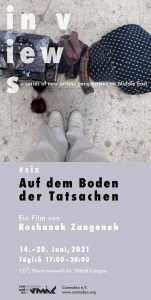
Artist statement on “Auf dem Boden der Tatsachen” (“Down to earth”)
With a background in cultural science and journalism, Zanganeh’s artistic work centers on conceptual art, captured in various media formats. Her works inlcude films, books and photography, published and displayed across several spaces in Europe and Middle East.
In addition to working as an artist, Roshanak is a co-founder of Contempory Middle East e. V. (conmidea.org).
Discover more on Roshanak Zangeneh on her website
GALLERY
FOLLOW US ON SOCIAL MEDIA:
LOCATION: Thürmchenswall 66 | D-50668 Köln
EMAIL: leila.cheraghi @co3art.com
TEL: +49 170 28 91 985
© 2024 CO³ — ALL RIGHTS RESERVED | WEBSITE DESIGN: STUDIO KOLY